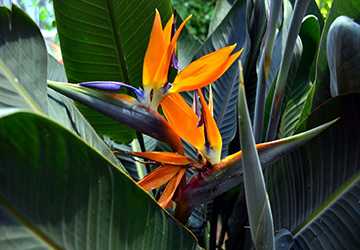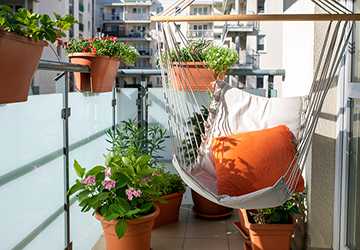Home gardens have long been a canvas for showcasing nature's art. In recent years, the trend has shifted towards cultivating exotic home plants. These plants enhance the garden's beauty and serve as conversation starters due to their unique appearances and, sometimes, their intriguing stories. While there are countless exotic home plants, certain ones stand out for their undeniable appeal. Let's explore the top 5 exotic plants that can transform your garden into a tropical paradise.
Bird of Paradise (Strelitzia reginae)
Origin: South Africa
With its majestic crane-like flowers, the Bird of Paradise has often been termed nature's masterpiece. The vivacity of its colors and the elegance with which the petals stretch out, imitating a bird taking flight, makes it one of the best tropical plants for home gardens. The leaves, broad and reminiscent of a banana plant, add a tropical touch even when the plant isn't blooming.

Care Tips:
● Sunlight: It thrives best under full sun or partial shade, making it versatile for various garden positions.
● Soil & Water: The plant demands well-draining soil. Overwatering can lead to root rot, so moderation is key.
Passion Flower (Passiflora)
Origin: South America
The Passion Flower's otherworldly beauty often captures the beholder's heart. Its intricate lace-like structures and radiant colors stand as a testament to the unique garden flora category. Moreover, its ability to bear the delicious passion fruit is a gardener bonus.
Care Tips:
● Sunlight: This vigorous vine loves full sun but tolerates partial shade.
● Support & Watering: Passion Flower needs a sturdy trellis to climb. Regular watering ensures a healthy growth trajectory.
Rafflesia
Origin: Southeast Asia
With its reputation as the "corpse flower," the Rafflesia might not be every gardener's first choice. Still, its sheer size and unique characteristics make it one of the most notable exotic home plants. The pungent odor it emits, akin to decaying flesh, attracts pollinators.
Care Tips:
● Environment: It thrives in a humid atmosphere, mimicking its natural rainforest habitat.
● Shade & Host: Rafflesia requires shaded conditions and relies on specific host plants for survival, making cultivating it challenging yet rewarding.
Pitcher Plant (Nepenthes)
Origin: Various tropical regions
The carnivorous Pitcher Plant is an exotic marvel. The plant's cup-like structures, filled with digestive fluids, lure, trap, and digest insects, showcasing the wonders of evolutionary adaptation. These vibrant "pitchers" are a sight to behold and are a fine specimen of unique garden flora.
Care Tips:
● Humidity & Sunlight: They flourish in high-humidity environments and prefer indirect sunlight.
● Watering: While they like moisture, waterlogged soil can be detrimental. Hence, regular but cautious watering is ideal.
Elephant Ear (Colocasia)
Origin: Southeast Asia and India
As the name suggests, the Elephant Ear plant is renowned for its colossal, heart-shaped leaves, resembling the ears of an elephant. Their sheer size and velvety texture make any garden space feel like a mini tropical paradise, solidifying their position among the best tropical plants.
Care Tips:
● Sunlight: These plants are sun-lovers but can tolerate partial shade.
● Moisture: They have a penchant for moisture. Regular watering, especially in dry conditions, will keep them thriving.
Why Opt for Exotic Plants? Deepening Our Understanding
For many gardening enthusiasts, including plants in their gardens has always gone beyond mere aesthetics. When one chooses to introduce exotic home plants, it's akin to embarking on an adventure, both in horticultural knowledge and cultural appreciation. Let's delve deeper into the multifaceted reasons for opting for these foreign wonders.
Broadening Horizons Through Plants
The world is a vast tapestry of ecological zones, each with unique flora and fauna. By choosing to cultivate exotic home plants, one consciously decides to explore this diversity. Every plant tells a story – from the rain-soaked leaves of the Amazonian flora to the sun-kissed petals of African succulents. They provide glimpses into distinct climatic conditions and the intricate relationships plants forge with the fauna in those regions. Thus, by bringing them into our gardens, we essentially bring parts of different continents into our homes, expanding our horizons right from our backyards.

Embracing the Challenge and Encouraging Learning
There's no doubt that nurturing unique garden flora is no easy task. These plants have evolved over millennia to thrive in specific conditions, often vastly different from what our local environment offers. Catering to their needs often necessitates extensive research, perhaps even consultations with fellow gardeners or horticulturists.
However, herein lies the beauty. The challenge of growing these plants becomes a continuous learning journey. Every successful bloom or new leaf becomes a testament to the gardener's skill and adaptability. Over time, this learning extends beyond just plant care. Gardeners often immerse themselves in the cultural histories, folklore, and traditional uses of these exotic home plants, leading to a richer, more holistic understanding of the world.
Enhancing Garden Diversity: A Celebration of Colors, Textures, and Forms
Most local gardens often have a similar palette – plants well-suited to the regional climate and soil. While these native plants have charm, introducing exotic home plants adds a vibrant splash of colors, shapes, and even fragrances.
Imagine the ethereal beauty of a Japanese cherry blossom tree standing next to a fiery South American heliconia. The juxtaposition creates a visual spectacle and introduces varied growth patterns and lifecycles.
This diversity can be particularly beneficial for local fauna. Birds, bees, and other pollinators get drawn to the garden, enhancing its ecosystem. Additionally, the varied textures and forms of unique garden flora can also influence the microclimate of a garden, providing shade in certain areas or retaining moisture in others.
The Responsibility of Growing Exotic Plants
While it's tempting to fill your garden with the best tropical plants, it's essential to remember that with the unique beauty of these plants comes a responsibility:
● Ecosystem Impact: Ensure that the exotic home plants you choose don't become invasive in your local ecosystem.
● Ethical Sourcing: Ensure you're sourcing plants ethically. Avoid species that are endangered or harvested unsustainably.
Conclusion
Home gardens, with their ability to transport us to different worlds, have always held a special place in our hearts. By introducing exotic home plants, you're elevating your space's aesthetic value and embracing a global culture of unique garden flora. As long as we remember our responsibilities and choose plants that align with our local conditions, the world of best tropical plants holds unparalleled beauty and wonder promises.


